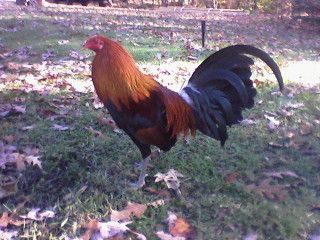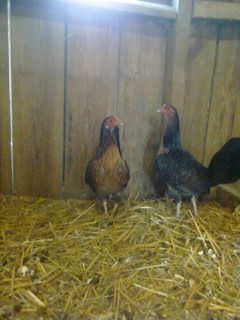Quote:
Written by Julia Keeling (Shamolady), via the Ultimatefowl Wikipedia.
"The Shamo is a tall bird with a muscular body and very short, hard, closely held feathers. The plumage is sparse revealing considerable exposed red skin. They have a cruel expression much like a bird of prey. The Shamo has an athletic body carried almost vertically on strong muscular legs. In Japan they are covered by a law to protect them from extinction and they are recognized as also having desirable meat characteristics. They were brought to Japan originally from Siam (Thailand) for cock fighting purposes in the 17th century and leave their imprint on many of the breeds that have their origin in Japan.
Chu Shamo and O Shamo are simply different weight classes of the breed SHAMO. Chu Shamo males weigh 3kg/ 6.6lbs or above, and under 4kg/8.8lbs. Females weigh 2.25kg/4.9lbs or above, and under 3kg/6.6lbs.
History
The Shamo is a naked heel gamefowl from Japan. The breed was originally brought into Japan from Thailand in the seventeenth century the name referring to Siam, the old name for Thailand. In Japan it was developed into a distinctive fighting bird of courage and ferocity. Its posture is very upright, with prominent shoulders, powerful bone structure, muscular athletic build and sparse hard feather, which all together make it an impressive and striking bird. The term Shamo covers all examples of the large fowl, but they can be further divided by weight into Chu Shamo (adult male weight above 3kg/6.6lbs) and O Shamo (adult male weight 4kg/8.8lbs and above). There is a huge weight range in this breed from a little hen of 4.9lbs to a huge cock of 12lbs or more. Breeders in Japan name their own lines after themselves or their areas, but names such as Makino, Osaka, Teramoto etc, often used in Europe, have no relevance once the line has left Japan. Different conditions, breeding choices and breeders mean that they should not continue to carry such names. All are Shamo. The breed can be found throughout Japan and although occasionally shown they are kept there primarily as fighting birds, with character and attitude being the vital attributes. Cockfighting is legal in Japan, although betting on the outcome is not. Colour is of no importance in this breed, although the plumage colour most commonly seen is black/red (bbr) and variations; beak yellow or horn; legs and feet yellow (with blackish over-colour being normal in some dark coloured birds); face red; and eyes silver or gold.
KEEPING SHAMO
The main thing to remember when keeping Shamo is that they should mature slowly. A bird of either sex is not adult until about two years old. The stag of ten months will look a different bird after another year. The problems this can bring are: The bones can develop slower than the body mass, so if the bird is fed too much protein and/or does not have enough fresh air and exercise as he grows, his body will get too heavy for his legs and result in serious leg problems. For the same reason, the breastbone can become bent if a young bird rests on too narrow a perch, and the legs and feet can become damaged from jumping down from too high a perch. Adult birds continue to need wide perches to accommodate long legs and bodies. Stags and pullets can run happily together when young, but as soon as they start to mature, maybe as late as seven or eight months old in bigger birds, they can turn on each other. Stags and pullets can quickly kill each other. So low protein food and lots of fresh air and exercise; wide, low perches, or none at all; and vigilance at all times re separating birds as soon as necessary.
Despite the aggressive, arrogant bearing, they should be calm and confident with their keepers and easy to handle. The aggression should only be towards other birds. Birds may well occasionally greet their keeper with a friendly peck, but this is certainly not man-fighting!
BREEDING SHAMO
Shamo take so long to mature that it doesnt really matter what time of year they are hatched. They will eventually reach their potential, even if they develop slowly over the winter. Shamo are a broody breed, but as hens are heavy and bony they can be clumsy with eggs. Usually better to remove eggs and let another hen hatch them. Running loose, a hen and cock can have their own space and live in harmony. However, if confined, they may fight. More than one hen with a cock may well fight each other, as well as it then being impossible to maintain accurate breeding records if not breeding one to one. Even if they live in apparent harmony, a heavy cock may seriously damage a hen with his spurs/claws. She should be examined regularly under her wings as she will show no signs of being hurt until wounds are really serious or become badly infected. This is a breed developed to fight and it is the most important characteristic of the breed, and this is what they will do!
British SHAMO Standard
(taken from the Japanese)
Origin: Japan Classification: Asian Hardfeather. Large Fowl. Egg colour: White or tinted
The Shamo is a Japanese bird of Malayoid type, originally imported to Japan from Thailand in the seventeenth century the name being a corruption of Siam, the old name for Thailand. In Japan it was developed into a fighting bird of unmatched courage and ferocity. Its feathers are sparse but strong and shiny, and its powerful bone structure and well-muscled body and legs, coupled with its erect posture, make it an impressive and striking bird. Since its importation in the early 1970s the term Shamo has covered all large fowl, but in Japanese classification, birds are divided into Chu (medium) Shamo and O (large) Shamo.
General characteristics: Male Type and Carriage: General appearance fierce, powerful, proud and alert. Stance very upright Body: Large and extremely firm with well-muscled abdomen. Breast: Broad and full with deep keel. Back: Long, broadest at shoulders, sloping down towards tail and gradually tapering from upper side of thigh. Backbone straight. Wings: short, big, strong and bony, carried well down and close to the body, not showing on the back but with prominent shoulders. Tail: carried below horizontal, length to give balance to the bird. Head: Deep and broad with wattles and earlobes small or absent. Beak strong, broad and curved downwards, but not hooked. Eyes deep-set under overhanging brows. Comb triple and firm. Walnut comb rare but also acceptable. Neck: Long, strong-boned, slightly curved but almost erect. Legs and feet: Legs medium to long thick and strong with slight bend at hock. Thighs long, round and muscular. Shanks thick , strong and round. Toes four, long and well spread. Hind toe straight and firm on the ground. Plumage: Feathers very short, narrow, hard and brilliant. Scant, and bare showing red skin at throat, keel and point of wing. Neck hackle feathers permitted to curl towards back of neck. Handling: Extremely firm fleshed, muscular and well-balanced. Strong contraction of wings to body.
Female The general characteristics are similar to those of the male, allowing for natural sexual differences. Stance very upright, but it is acceptable for a female to be slightly less upright than the male.
Colour Black/red is the most common colour seen. (The red may be any shade from yellow to dark red, with wheaten or partridge females which can be any shade from cream to dark brown, with or without dark markings). Ginger, white, black, splash, blue and duckwing are all recognised, and no colour or combination of colours is disqualified. In both sexes and all colours: Beak yellow or horn. Legs and feet yellow. Blackish overcolour acceptable in dark coloured birds. Comb, face, throat, earlobes and any exposed skin brilliant red. Eyes silver or gold. Darker eyes acceptable in young birds.
Weights Male 3kg (6lb10oz) minimum Female 2.25kg (4lb14oz) minimum [Chu Shamo male above 3kg (6lb10oz) and under 4kg (8lb12oz), female above 2.25kg (4lb14oz) and under 3kg (6lb10oz). O Shamo male 4kg (8lb12oz) and above, female 3kg (6lb10oz) and above.]
Scale of points Type and carriage 40 Head 20 Feather/condition 20 Legs and feet 20 /100
Serious defects Lack of attitude. Poor carriage. Overlarge comb. Duck feet. " Any questions you may have I'd be willing to answer as well, especially if you PM me.. I don't claim to be an expert at all, these are new birds to me. I've had a rooster for a little over a year now but haven't been able to breed any and play with them yet. That comes next year now that I got more stock.
BUT, I have spoken with Miss Julia a lot and researched the breed. So will help in passing along information, and if I'm not sure.. Will contact Miss Julia.
-Daniel
ETA: Miss Julia's photo gallery over on Ganoi.
http://www.ganoi.com/photopost/showgallery.php?cat=500&ppuser=100340
Those birds will be correct Shamo type, she is strongly against birds being called Shamo that do not exhibit the Shamo type.. So all of those crele/dom colored Shamos you see, all of the ones with green legs, red eyes, high tails, etc (there is quite the list lol..) she doesn't tip toe around and will say up front it is NOT Shamo. In North America, it is hard to get good quality Shamos though, you have to be careful.. I would say Jim Zook is the best for a cheaper route, if you wait a couple years Moua Oriental Aviary will be the best I'd say.. He has stock directly from Miss Julia.. Imports, and haven't been crossed. They will be expensive though I imagine, have to see.




